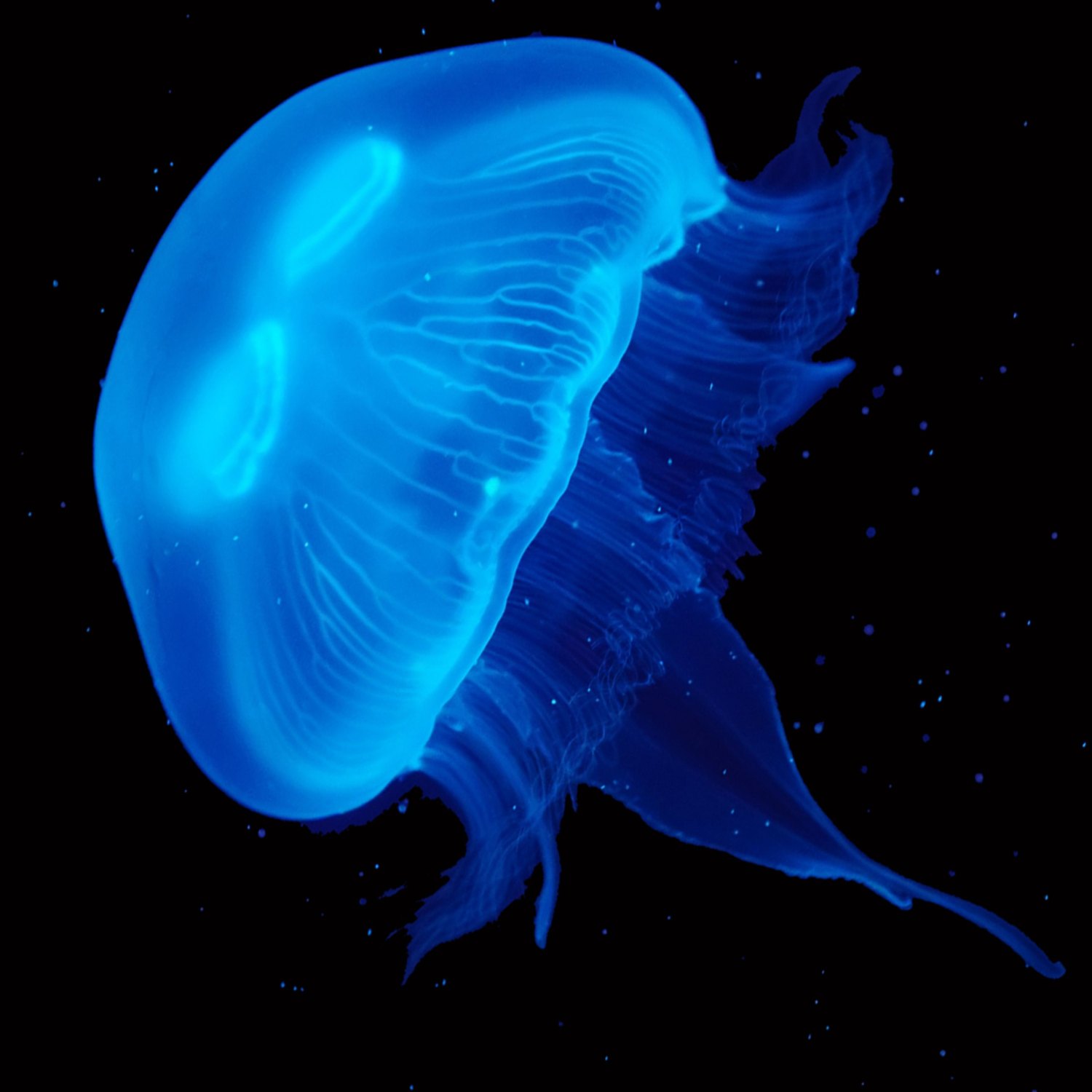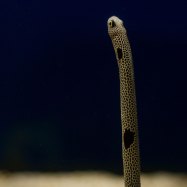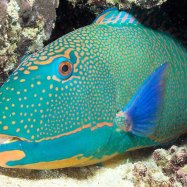
Freshwater Jellyfish
1 to 3 centimeters
Freshwater Jellyfish, also known as Olindiidae, are small creatures that measure 1 to 3 cm in length and can be found in freshwater bodies all over the world. These umbrella-shaped jellies have long tentacles that dangle beneath them, making them a beautiful and mesmerizing sight to behold. So if you happen to come across one during your next outdoor adventure, don't be afraid, just admire their unique beauty from a safe distance. #FreshwaterJellyfish #Olindiidae #WaterWonders
Animal Details Summary:
Common Name: Freshwater Jellyfish
Kingdom: Animalia
Habitat: Freshwater lakes, ponds, and rivers
The Mesmerizing World of Freshwater Jellyfish
When we think of jellyfish, we usually imagine them gracefully floating in the ocean, their ethereal bodies illuminated by the sun rays. But did you know that there is a species of jellyfish that lives in freshwater? The freshwater jellyfish, also known by its scientific name Craspedacusta sowerbyi, is a fascinating creature that inhabits lakes, ponds, and rivers around the world. In this article, we will delve into the mesmerizing world of freshwater jellyfish and discover what makes them so unique.Native to China, freshwater jellyfish is now found globally, making it a widely distributed species Freshwater Jellyfish. They were first discovered in a pond in England in 1880, and since then, they have been spotted in freshwater bodies in Europe, Asia, Australia, and North America. Despite their global presence, freshwater jellyfish remains a mystery for many, and scientists are continually studying this elusive creature to uncover its secrets.
Classification and Habitat
Freshwater jellyfish belong to the kingdom Animalia, the phylum Cnidaria, and the class Hydrozoa. These fragile creatures are part of the order Limnomedusae and the family Olindiidae. Much like their ocean-dwelling relatives, freshwater jellyfish also have a bell-shaped body, with tentacles hanging down from the edges.
Freshwater jellyfish are small creatures, with an average length of 1 to 3 centimeters. They are mostly transparent with a pale blue coloration that allows them to camouflage in their freshwater environment. This translucent appearance makes them a sight to behold as their delicate bodies gracefully move through the water.
As their name suggests, freshwater jellyfish can only survive in freshwater bodies, mainly lakes, ponds, and slow-moving rivers Forest Cuckoo Bumblebee. They are typically found in calm and still waters, where they can easily catch their prey and avoid being swept away by strong currents. Freshwater jellyfish prefer to live in environments with low levels of pollution and high levels of oxygen. They also require some plant life to feed on, making them an indicator species of a healthy ecosystem.
Feeding and Predators
Freshwater jellyfish are carnivorous creatures that primarily feed on small crustaceans, plankton, and other tiny aquatic animals. They use their long tentacles to capture their prey and bring it towards their mouth, located in the center of their bell-shaped body. Their tentacles are also equipped with stinging cells called nematocysts, which they use to immobilize their prey.
Although freshwater jellyfish are predators themselves, they have several natural predators in their environment. Some of these predators include other jellyfish species, fish, and birds. These creatures are not considered a threat to humans, as they are too small to cause any significant harm.
The Life Cycle of Freshwater Jellyfish
The life cycle of freshwater jellyfish is a complex and intriguing process that involves two stages - the polyp stage and the medusa stage. During the polyp stage, freshwater jellyfish attach themselves to submerged plants or rocks and grow into a branching colony of polyps. These polyps are capable of reproducing asexually by producing tiny jellyfish polyps, called ephyrae, through a process called strobilation.
As the ephyrae mature, they detach from the polyp and become free-swimming medusae, or adult freshwater jellyfish. This medusa stage is when the freshwater jellyfish are most visible and can be seen floating in the water, feeding and reproducing. The lifespan of freshwater jellyfish is relatively short, with most individuals living only for a few months.
The Enigma of Freshwater Jellyfish
Despite being found globally and considered an invasive species in some areas, the natural history of freshwater jellyfish remains a bit of a mystery. Scientists are still trying to understand how they were able to adapt and survive in freshwater environments, as their ocean-dwelling relatives lack the ability to survive in freshwater.
One theory suggests that freshwater jellyfish were once marine species, but due to changes in the Earth's environment, they were forced to adapt and remain in freshwater bodies. Another possible explanation is that they are remnants of a once thriving group of freshwater jellyfish that are now extinct. Whatever the case may be, these elusive creatures have sparked the curiosity of scientists and continue to intrigue us with their presence.
Benefits and Risks of Freshwater Jellyfish
As with any species, freshwater jellyfish have both benefits and risks associated with their presence. On one hand, they serve as an important food source for their predators, and their presence in freshwater bodies is an indicator of a healthy and balanced ecosystem.
On the other hand, freshwater jellyfish can also pose a threat to human activities such as swimming, fishing, and agriculture. Their small size makes them difficult to detect, and their stinging cells can cause mild discomfort and skin irritation to humans. In some cases, their population growth can also disrupt the natural balance of an ecosystem, affecting other species and their habitats.
Tips for Spotting Freshwater Jellyfish in the Wild
- Be on the lookout for calm and still freshwater bodies, such as lakes and ponds.
- The best time to spot freshwater jellyfish is during the summer and early fall.
- Look for small, translucent creatures with an umbrella-shaped bell and tentacles hanging down.
- Take a closer look at submerged plants and rocks, where freshwater jellyfish tend to attach themselves during the polyp stage.
In Conclusion
Freshwater jellyfish may be small creatures, but they have managed to capture our imagination with their mesmerizing presence. From their unique ability to survive in freshwater environments to their mysterious origins, this species continues to fascinate scientists and nature enthusiasts alike. The next time you visit a calm and still freshwater body, keep an eye out for the graceful movements of these fragile yet captivating creatures - the freshwater jellyfish.

Freshwater Jellyfish
Animal Details Freshwater Jellyfish - Scientific Name: Craspedacusta sowerbyi
- Category: Animals F
- Scientific Name: Craspedacusta sowerbyi
- Common Name: Freshwater Jellyfish
- Kingdom: Animalia
- Phylum: Cnidaria
- Class: Hydrozoa
- Order: Limnomedusae
- Family: Olindiidae
- Habitat: Freshwater lakes, ponds, and rivers
- Feeding Method: Carnivorous
- Geographical Distribution: Native to China, but now found globally
- Country of Origin: China
- Location: Freshwater bodies worldwide
- Animal Coloration: Transparent to pale blue
- Body Shape: Umbrella-shaped bell with tentacles hanging down
- Length: 1 to 3 centimeters

Freshwater Jellyfish
- Adult Size: Small
- Average Lifespan: 2 to 6 months
- Reproduction: Sexual or asexual (budding)
- Reproductive Behavior: Mating and release of fertilized eggs or development of directly released larvae
- Sound or Call: None
- Migration Pattern: Non-migratory
- Social Groups: Solitary
- Behavior: Drifts with water currents
- Threats: Pollution, habitat destruction, invasive species
- Conservation Status: Not Evaluated (NE) on the IUCN Red List
- Impact on Ecosystem: Can compete with native species for food and disrupt the balance of ecosystems
- Human Use: None
- Distinctive Features: Transparent body, four long tentacles with nematocysts
- Interesting Facts: Freshwater jellyfish are the only jellyfish that can reproduce sexually and asexually.
- Predator: Predator-free in some habitats, but can be preyed upon by fish and other aquatic organisms

Craspedacusta sowerbyi
The Mysterious World of Freshwater Jellyfish
When we think of jellyfish, we often imagine large, gelatinous creatures lurking in the depths of the ocean. However, did you know that there are also freshwater jellyfish that live in lakes, ponds, and even rivers? These elusive creatures may be small in size, but they possess unique features and behaviors that make them a fascinating species to study.Freshwater jellyfish belong to the class Hydrozoa, along with their marine counterparts, and are known scientifically as Craspedacusta sowerbyi. They are found in various parts of the world, including North America, Europe, and Asia PeaceOfAnimals.Com. Due to their small size and elusive nature, these creatures often go unnoticed by humans, but they play a significant role in the ecosystems they inhabit.
In this article, we will dive into the world of freshwater jellyfish and explore their distinctive features, behaviors, and impact on the environment.
The Size of Small
Unlike their ocean-dwelling cousins, freshwater jellyfish are incredibly small in size. They typically range from 2 to 25 millimeters in diameter, with the largest known species being only the size of a penny. This makes them some of the smallest jellyfish in the world. Their tiny size, coupled with their translucent bodies, allows them to blend seamlessly into their surroundings, making them challenging to spot.Despite their diminutive size, these creatures possess powerful stinging cells known as nematocysts, which they use for self-defense and stunning their prey. The nematocysts are found on their four long tentacles, which are used for capturing tiny crustaceans and other microorganisms for food.
The Short-lived Life of Freshwater Jellyfish
The lifespan of freshwater jellyfish is relatively short, usually only lasting between 2 to 6 months Fire Ball Python. This is due to their vulnerability to environmental conditions and various threats they face, such as pollution and habitat destruction. These factors also make it challenging to study them and gather accurate data on their population and behaviors.Another interesting fact about their lifespan is that it can vary depending on their reproductive method. Freshwater jellyfish have the unique ability to reproduce both sexually and asexually, allowing them to adapt and survive in changing environments.
The Mysterious Reproductive Behavior
One of the most intriguing aspects of freshwater jellyfish is their reproductive behavior. As mentioned earlier, they have the ability to reproduce sexually and asexually, making them the only known jellyfish to do so. This reproductive versatility allows them to quickly increase their population, especially in favorable conditions.When reproducing sexually, freshwater jellyfish engage in a unique mating behavior. The male jellyfish release sperm into the water, which is then collected by the female's oral arms. The fertilized eggs are then released into the water, where they develop directly into tiny larvae.
In asexual reproduction, freshwater jellyfish use a method called "budding." This involves a part of the jellyfish's body breaking off and developing into a new individual. This process allows them to reproduce without the need for a mate, giving them a higher chance of survival in harsh environments.
Unheard Sounds and Lone Drifters
Unlike many marine jellyfish that produce distinct sounds or calls, freshwater jellyfish are silent creatures. As a result, they do not communicate with each other through sound, as some marine species do.Another interesting behavior of freshwater jellyfish is that they are solitary creatures. They do not form any social groups or colonies, and each individual drifts alone with the water currents. This behavior is believed to be an adaptation to their constantly changing environment, allowing them to travel to areas with better food sources and conditions.
Threatened Existence
Despite their elusive nature, freshwater jellyfish face numerous threats that affect their survival and population. Pollution from human activities, such as agricultural runoff and waste disposal, can cause the water they inhabit to become toxic, leading to their death.Habitat destruction is another significant threat to freshwater jellyfish. As human development continues to encroach on natural habitats, these creatures lose their homes and food sources, making it challenging to survive. Invasive species, such as predatory fish, can also have a severe impact on freshwater jellyfish populations by preying on them.
The Unknown Conservation Status
Despite facing numerous threats, the conservation status of freshwater jellyfish remains unknown. They are listed as "Not Evaluated" (NE) on the International Union for Conservation of Nature (IUCN) Red List, indicating a lack of sufficient data to determine their population and potential risk of extinction.This lack of information highlights the need for further research and conservation efforts to protect these elusive creatures and the ecosystems they inhabit.
The Ripple Effect on Ecosystems
The presence of freshwater jellyfish in an ecosystem may seem insignificant at first glance. However, their impact on the environment is much more substantial than their small size may suggest.They play a vital role in the food chain, both as predators of tiny crustaceans and as prey for larger organisms. Their presence also helps maintain the balance of ecosystems, preventing the overpopulation of certain species. But, as with any living creature, an increase or decrease in their population can have a domino effect on the entire ecosystem.
In recent years, there have been reports of large blooms of freshwater jellyfish in certain areas, leading to concerns about their potential to outcompete native species for food and disrupt the balance of ecosystems. This further emphasizes the need for continued research on these mysterious creatures and their role in the environment.
Not for Human Consumption
While some marine jellyfish are considered a delicacy in some cultures, freshwater jellyfish are not suitable for human consumption. Their small size and elusive nature make them unsuitable for fishing on an industrial scale, and there is no known cultural significance or tradition of consuming them.It is essential to note that even though they may be invisible to the human eye, the presence of freshwater jellyfish in bodies of water indicates that the ecosystem is healthy and thriving. It is best to leave these creatures undisturbed and let them play their crucial role in the environment.
Distinctive Features and Interesting Facts
Freshwater jellyfish have various unique features that make them stand out from their marine counterparts. One of the most distinctive features is their transparent body, allowing them to blend seamlessly into their surroundings.They also have four long tentacles, each with nematocysts used for hunting and defense. Interestingly, these creatures are the only known jellyfish to have the ability to reproduce sexually and asexually, making them a remarkable species to study.
Invisible Predators and Prey
Being small and elusive, freshwater jellyfish do not have many predators in their natural habitat. However, fish and other aquatic organisms can sometimes prey upon them, especially in areas where their populations have increased due to favorable conditions.On the other hand, being predators themselves, freshwater jellyfish feed on tiny crustaceans and other microorganisms, making them essential players in the food chain of their ecosystem.
The Need for Further Exploration
Despite their small size and elusiveness, freshwater jellyfish are a fascinating species with many unique features and behaviors. However, due to their vulnerability and limited research, there is still much to learn about these mysterious creatures.It is crucial to continue studying and understanding freshwater jellyfish to protect them from threats and preserve their role in the environment. Furthermore, these creatures could potentially hold the key to unlocking valuable information and medical advancements, making them an essential area of study for scientists and researchers.
In conclusion, freshwater jellyfish may be small and invisible, but their impact on ecosystems and their unique features make them a significant and fascinating species. Let us continue to explore and appreciate the mysterious world of these creatures to ensure their survival and conserve their delicate ecosystems.

The Mesmerizing World of Freshwater Jellyfish
Disclaimer: The content provided is for informational purposes only. We cannot guarantee the accuracy of the information on this page 100%. All information provided here may change without prior notice.












